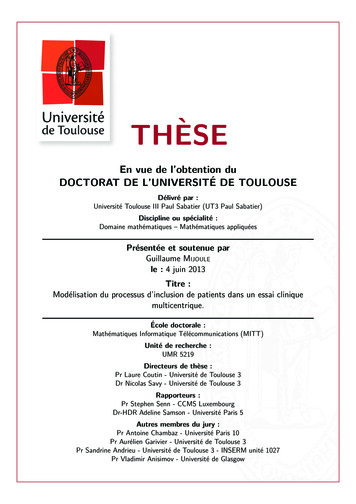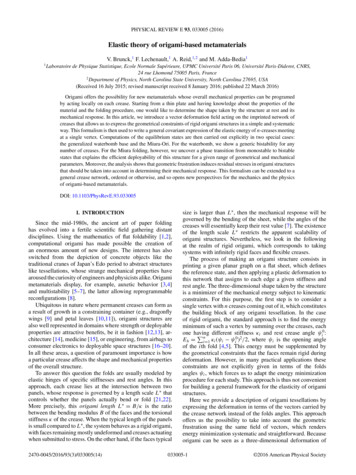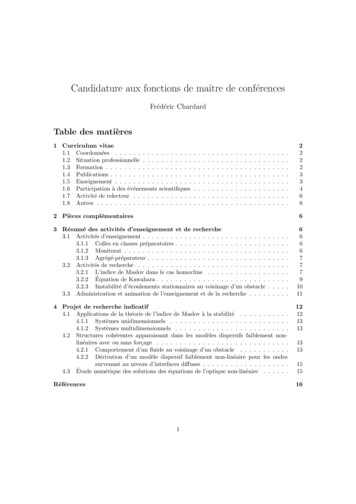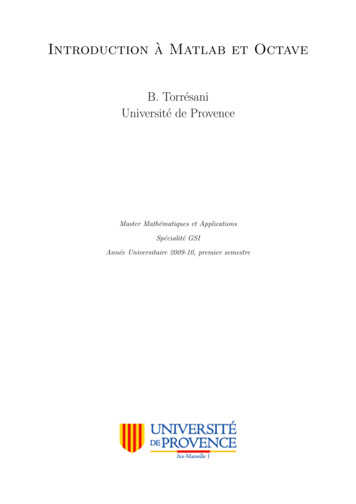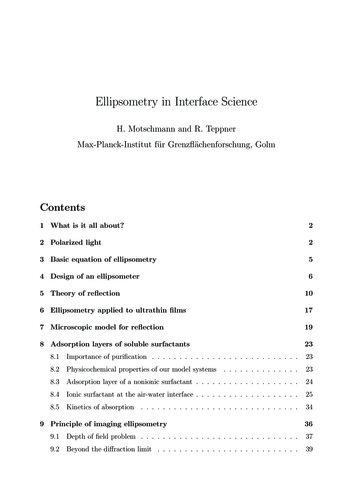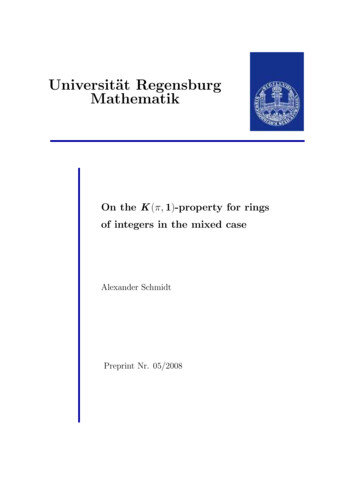
Transcription
Universität RegensburgMathematikOn the K (π, 1)-property for ringsof integers in the mixed caseAlexander SchmidtPreprint Nr. 05/2008
On the K(π, 1)-property for rings ofintegers in the mixed caseby Alexander SchmidtJanuary 14, 2008AbstractWe investigate the Galois group GS (p) of the maximal p-extension unramified outside a finite set S of primes of a number field in the (mixed)case, when there are primes dividing p inside and outside S. We show thatthe cohomology of GS (p) is ‘often’ isomorphic to the étale cohomology ofthe scheme Spec(Ok rS), in particular, GS (p) is of cohomological dimension 2 then. We deduce this from the results in our previous paper [Sch2],which mainly dealt with the tame case.1IntroductionLet Y be a connected locally noetherian scheme and let p be a prime number.We denote the étale fundamental group of Y by π1 (Y ) and its maximal prop factor group by π1 (Y )(p). The Hochschild-Serre spectral sequence inducesnatural homomorphismsiφi : H i (π1et (Y )(p), Z/pZ) Het(Y, Z/pZ), i 0,and we call Y a ‘K(π, 1) for p’ if all φi are isomorphisms; see [Sch2] Proposition 2.1 for equivalent conditions. See [Wi2] for a purely Galois cohomologicalapproach to the K(π, 1)-property. Our main result is the followingTheorem 1.1. Let k be a number field and let p be a prime number. Assumethat k does not contain a primitive p-th root of unity and that the class numberof k is prime to p. Then the following holds:Let S be a finite set of primes of k and let T be a set of primes of k ofDirichlet density δ(T ) 1. Then there exists a finite subset T1 T such thatSpec(Ok )r(S T1 ) is a K(π, 1) for p.Remarks. 1. If S contains the set Sp of primes dividing p, then Theorem 1.1holds with T1 and even without the condition ζp / k and Cl(k)(p) 0,see [Sch2], Proposition 2.3. In the tame case S Sp , the statement ofTheorem 1.1 is the main result of [Sch2]. Here we provide the extension to the‘mixed’ case S Sp Sp .1
2. For a given number field k, all but finitely many prime numbers p satisfy thecondition of Theorem 1.1. We conjecture that Theorem 1.1 holds without therestricting assumption on p.Let S be a finite set of places of a number field k. Let kS (p) be the maximalp-extension of k unramified outside S and put GS (p) Gal(kS (p) k). If SRdenotes the set of real places of k, then GS SR (p) π1 (Spec(Ok )rS)(p) (wehave GS (p) GS SR (p) if p is odd or k is totally imaginary). The followingTheorem 1.2 sharpens Theorem 1.1.Theorem 1.2. The set T1 T in Theorem 1.1 may be chosen such that(i) T1 consists of primes p of degree 1 with N (p) 1 mod p,(ii) (kS T1 (p))p kp (p) for all primes p S T1 .Note that Theorem 1.2 provides nontrivial information even in the case S Sp , where assertion (ii) was only known when k contains a primitive p-th rootof unity (Kuz’min’s theorem, see [Kuz] or [NSW], 10.6.4 or [NSW2 ], 10.8.4,respectively) and for certain CM fields (by a result of Mukhamedov, see [Muk]or [NSW], X §6 exercise or [NSW2 ], X §8 exercise, respectively).By Theorem 3.3 below, Theorem 1.2 provides many examples of GS (p) beinga duality group. If ζp / k, this is interesting even in the case that S Sp , whereexamples of GS (p) being a duality group were previously known only for realabelian fields and for certain CM-fields (see [NSW], 10.7.15 and [NSW2 ], 10.9.15,respectively, and the remark following there).Previous results in the mixed case had been achieved by K. Wingberg [Wi1],Ch. Maire [Mai] and D. Vogel [Vog]. Though not explicitly visible in this paper,the present progress in the subject was only possible due to the results on mildpro-p groups obtained by J. Labute in [Lab].I would like to thank K. Wingberg for pointing out that the proof of Proposition 8.1 in my paper [Sch2] did not use the assumption that the sets S andS 0 are disjoint from Sp . This was the key observation for the present paper.The main part of this text was written while I was a guest at the Departmentof Mathematical Sciences of Tokyo University and of the Research Institute forMathematical Sciences in Kyoto. I want to thank these institutions for theirkind hospitality.2Proof of Theorems 1.1 and 1.2We start with the observation that the proofs of Proposition 8.2 and Corollary 8.3 in [Sch2] did not use the assumption that the sets S and S 0 are disjointfrom Sp . Therefore, with the same proof (which we repeat for the convenienceof the reader) as in loc. cit., we obtain2
Proposition 2.1. Let k be a number field and let p be a prime number. Assumek to be totally imaginary if p 2. Put X Spec(Ok ) and let S S 0 be finitesets of primes of k. Assume that XrS is a K(π, 1) for p and that GS (p) 6 1.Further assume that each p S 0 rS does not split completely in kS (p). Thenthe following hold.(i) XrS 0 is a K(π, 1) for p.(ii) kS 0 (p)p kp (p) for all p S 0 rS.Furthermore, the arithmetic form of Riemann’s existence theorem holds, i.e.,setting K kS (p), the natural homomorphism p S 0 \S(K)T (Kp (p) Kp ) Gal(kS 0 (p) K)is an isomorphism. Here T (Kp (p) Kp ) is the inertia group and denotes the freepro-p-product of a bundle of pro-p-groups, cf. [NSW], Ch. IV, §3. In particular,Gal(kS 0 (p) kS (p)) is a free pro-p-group.Proof. The K(π, 1)-property impliesiH i (GS (p), Z/pZ) (XrS, Z/pZ) 0 for i 4, Hethence cd GS (p) 3. Let p S 0 rS. Since p does not split completely inkS (p) and since cd GS (p) , the decomposition group of p in kS (p) k is anon-trivial and torsion-free quotient of Zp Gal(kpnr (p) kp ). Therefore kS (p)pis the maximal unramified p-extension of kp . We denote the normalization ofan integral normal scheme Y in an algebraic extension L of its function field byYL . Then (XrS)kS (p) is the universal pro-p covering of XrS. We consider theétale excision sequence for the pair ((XrS)kS (p) , (XrS 0 )kS (p) ). By assumption,i((XrS)kS , Z/pZ) 0 for i 1 by [Sch2],XrS is a K(π, 1) for p, hence HetProposition 2.1. Omitting the coefficients Z/pZ from the notation, this impliesisomorphismsM0 iHpi 1 ((XrS)kS )pHet(XrS 0 )kS (p) p S 0 rS(kS (p))for i 1. Here (and in variants also below) we use the notational conventionM0M Hpi 1 ((XrS)kS (p) )p : limHpi 1 ((XrS)K )p , p S 0 rS(kS (p))K kS (p) p S 0 rS(K)where K runs through the finite extensions of k inside kS (p). As kS (p) realizes the maximal unramified p-extension of kp for all p S 0 rS, the schemes((XrS)kS (p) )p , p S 0 rS(kS (p)), have trivial cohomology with values in Z/pZand we obtain isomorphisms H i ((kS (p))p ) Hpi 1 ((XrS)kS (p) )pfor i 1. These groups vanish for i 2. This impliesiHet((XrS 0 )kS (p) ) 03
for i 2. Since the scheme (XrS 0 )kS0 (p) is the universal pro-p covering of(XrS 0 )kS (p) , the Hochschild-Serre spectral sequence yields an inclusion2H 2 (Gal(kS 0 (p) kS (p))) , Het((XrS 0 )kS (p) ) 0.Hence Gal(kS 0 (p) kS (p)) is a free pro-p-group andM0 1H 1 (Gal(kS 0 (p) kS (p))) Het((XrS 0 )kS (p) ) p S 0 rS(kH 1 (kS (p)p ).S (p))We set K kS (p) and consider the natural homomorphismφ: p S 0 \S(K)T (Kp (p) Kp ) Gal(kS 0 (p) K).By the calculation of the cohomology of a free product ([NSW], 4.3.10 and 4.1.4),φ is a homomorphism between free pro-p-groups which induces an isomorphismon mod p cohomology. Therefore φ is an isomorphism. In particular, kS 0 (p)p kp (p) for all p S 0 rS. Using that Gal(kS 0 (p) kS (p)) is free, the HochschildSerre spectral sequence ji jE2ij H i Gal(kS 0 (p) kS (p)), Het((XrS 0 )kS0 (p) ) Het((XrS 0 )kS (p) )induces an isomorphism 220 Het((XrS 0 )kS (p) ) Het((XrS 0 )kS0 (p) )Gal(kS0 kS ) .2((XrS 0 )kS0 (p) ) 0, since Gal(kS 0 (p) kS (p)) is a pro-p-group. NowHence Het[Sch2], Proposition 2.1 implies that XrS 0 is a K(π, 1) for p.In order to prove Theorem 1.1, we first provide the following lemma. Foran extension field K k and a set of primes T of k, we write T (K) for the set ofprolongations of primes in T to K and δK (T ) for the Dirichlet density of theset of primes T (K) of K.Lemma 2.2. Let k be a number field, p a prime number and S a finite set ofnonarchimedean primes of k. Let T be a set of primes of k with δk(µp ) (T ) 1.Then there exists a finite subset T0 T such that all primes p S do not splitcompletely in the extension kT0 (p) k.Proof. By [NSW], 9.2.2 (ii) or [NSW2 ], 9.2.3 (ii), respectively, the restrictionmapYH 1 (GT S Sp SR (p), Z/pZ) H 1 (kp , Z/pZ)p S Sp SRis surjective. A class in α H 1 (GT S Sp SR (p), Z/pZ) which restricts to an1unramified class αp Hnr(kp , Z/pZ) for all p S Sp SR is contained in1H (GT (p), Z/pZ). Therefore the image of the composite mapYH 1 (GT (p), Z/pZ) , H 1 (GT S Sp SR (p), Z/pZ) H 1 (kp , Z/pZ)p S4
Q1contains the subgroup p S Hnr(kp , Z/pZ). As this group is finite, it is already1contained in the image of H (GT0 (p), Z/pZ) for some finite subset T0 T . Weconclude that no prime in S splits completely in the maximal elementary abelianp-extension of k unramified outside T0 .Proof of Theorems 1.1 and 1.2. As p 6 2, we may ignore archimedean primes.Furthermore, we may remove the primes in S Sp and all primes of degree greaterthan 1 from T . In addition, we remove all primes p with N (p) 6 1 mod p fromT . After these changes, we still have δk(µp ) (T ) 1.By Lemma 2.2, we find a finite subset T0 T such that no prime in S splitscompletely in kT0 (p) k. Put X Spec(Ok ). By [Sch2], Theorem 6.2, appliedto T0 and T rT0 , we find a finite subset T2 T rT0 such that Xr(T0 T2 ) isa K(π, 1) for p. Then Proposition 2.1 applied to T0 T2 S T0 T2 , showsthat also Xr(S T0 T2 ) is a K(π, 1) for p. Now put T1 T0 T2 T .It remains to show Theorem 1.2. Assertion (i) holds by construction of T1 .By [Sch2], Lemma 4.1, also Xr(S 0 T1 ) is a K(π, 1) for p. By [Sch2], Theorem 3,the field kT1 (p) realizes kp (p) for p T1 , showing (ii) for these primes. Finally,assertion (ii) for p S follows from Proposition 2.1.3DualityWe start by investigating the relation between the K(π, 1)-property and theuniversal norms of global units.Let us first remove redundant primes from S: If p - p is a prime with ζp / kp ,then every p-extension of the local field kp is unramified (see [NSW], 7.5.1 or[NSW2 ], 7.5.9, respectively). Therefore primes p / Sp with N (p) 6 1 mod pcannot ramify in a p-extension. Removing all these redundant primes from S,we obtain a subset Smin S, which has the property that GS (p) GSmin (p).Furthermore, by [Sch2], Lemma 4.1, XrS is a K(π, 1) for p if and only ifXrSmin is a K(π, 1) for p.Theorem 3.1. Let k be a number field and let p be a prime number. Assumethat k is totally imaginary if p 2. Let S be a finite set of nonarchimedeanprimes of k. Then any two of the following conditions (a) – (c) imply the third.(a) Spec(Ok )rS is a K(π, 1) for p. (b) limK k (p) OK Zp 0. S(c) (kS (p))p kp (p) for all primes p Smin .The limit in (b) runs through all finite extensions K of k inside kS (p). If (a)–(c)hold, then also lim OK,S Zp 0.min K kS (p)Remarks: 1. Assume that ζp k and S Sp . Then (a) holds and condition(b) holds for p 2 if #S r2 2 (see [NSW2 ], Remark 2 after 10.9.3). In the5
case k Q(ζp ), S Sp , condition (b) holds if and only if p is an irregular primenumber.2. Assume that S Sp and Smin 6 . If condition (a) holds, then eitherGS (p) 1 (which only happens in very special situations, see [Sch2], Proposition7.4) or (b) holds by [Sch2], Theorem 3 (or by Proposition 3.2 below).Proof of Theorem 3.1. We may assume S Smin in the proof. Let K runthrough the finite extensions of k in kS (p) and put XK Spec(OK ). Applyingthe topological Nakayama-Lemma ([NSW], 5.2.18) to the compact Zp -module lim OK Zp , we see that condition (b) is equivalent to (b)’limO /p 0. K kS (p) KFurthermore, by [Sch2], Proposition 2.1, condition (a) is equivalent to(a)’ilimK k (p) Het((XrS)K , Z/pZ) 0 for i 1. SCondition (a)’ always holds for i 1, i 4, and it holds for i 3 provided thatGS (p) is infinite or S is nonempty or ζp / k (see [Sch2], Lemma 3.7). The flat·pKummer sequence 0 µp Gm Gm 0 induces exact sequences 0 OK/p Hfl1 (XK , µp ) p Pic(X) 0for all K. As the field kS (p) does not have nontrivial unramified p-extensions,class field theory implieslim p Pic(XK )K kS (p) lim Pic(XK ) Zp 0.K kS (p)As we assumed k to be totally imaginary if p 2, the flat duality theorem ofArtin-Mazur ([Mil], III Corollary 3.2) induces natural isomorphisms2Het(XK , Z/pZ) Hfl2 (XK , Z/pZ) Hfl1 (XK , µp ) .We conclude that( )lim 2Het(XK , Z/pZ) K kS (p)lim OK/p .K kS (p)We first show the equivalence of (a) and (b) in the case S . If (a)’ holds,then ( ) shows (b)’. If (b) holds, then ζp / k or GS (p) is infinite. Hence weobtain (a)’ for i 3. Furthemore, (b)’ implies (a)’ for i 2 by ( ). This finishesthe proof of the case S .Now we assume that S 6 . For p S(K), a standard calculation of localcohomology shows that 0for i 1, 11H(K,Z/pZ)/H(K,Z/pZ)for i 2,ppnrHpi (XK , Z/pZ) 2H(K,Z/pZ)for i 3. p 0for i 4.6
For p S Smin , every proper Galois subextension of kp (p) kp admits ramifiedp-extensions. Hence condition (c) is equivalent toL(c)’limK k (p) p S(K) Hpi (XK , Z/pZ) 0 for all i, Sand to(c)”limK k (p) SLp S(K)Hp2 (XK , Z/pZ) 0.Consider the direct limit over all K of the excision sequencesMii··· Hpi (XK , Z/pZ) Het(XK , Z/pZ) Het((XrS)K , Z/pZ) · · · .p S(K)Assume that (a)’ holds, i.e. the right hand terms vanish in the limit for i 1.Then ( ) shows that (b)’ is equivalent to (c)”.Now assume that (b) and (c) hold. As above, (b) implies the vanishing ofthe middle term for i 2, 3 in the limit. Condition (c)’ then shows (a)’.We have proven that any two of the conditions (a)–(c) imply the third.Finally, assume that (a)–(c) hold. Tensoring the exact sequences (cf. [NSW],10.3.11 or [NSW2 ], 10.3.12, respectively)M 0 OK OK,S (Kp /Up ) Pic(XK ) Pic((XrS)K ) 0p S(K)by (the flat Z-algebra) Zp , we obtain exact sequences of finitely generated, hencecompact, Zp -modules. Passing to the projective limit over the finite extensionsK of k inside kS (p) and using lim Pic(XK ) Zp 0, we obtain the exact sequenceM (Kp /Up ) Zp 0.0 lim OK Zp lim OK,S Zp lim K kS (p)K kS (p)K kS (p) p S(K)Condition (c) and local class field theory imply the vanishing of the right handlimit. Therefore (b) implies the vanishing of the projective limit in the middle.If GS (p) 6 1 and condition (a) of Theorem 1.1 holds, then the failure incondition (c) can only come from primes dividing p. This follows from the nextProposition 3.2. Let k be a number field and let p be a prime number. Assumethat k is totally imaginary if p 2. Let S be a finite set of nonarchimedeanprimes of k. If Spec(Ok )rS is a K(π, 1) for p and GS (p) 6 1, then every primep S with ζp kp has an infinite inertia group in GS (p). Moreover, we havekS (p)p kp (p)for all p Smin rSp .7
Proof. We may assume S Smin . Suppose p S with ζp kp does not ramifyin kS (p) k. Setting S 0 Sr{p}, we have kS 0 (p) kS (p), in particular, 11Het(XrS 0 , Z/pZ) Het(XrS, Z/pZ).In the following, we omit the coefficients Z/pZ from the notation. Using the3vanishing of Het(XrS), the étale excision sequence yields a commutative exactdiagramH 2 (GS 0 (p))Hp2 (X) / H 2 (XrS 0 )et / H 2 (GS (p))α / H 2 (XrS)eto/ Hp3 (X)/ / H 3 (XrS 0 ).et 3Hence α is split-surjective and Z/pZ (XrS 0 ). This implies Hp3 (X) Het0S , hence S {p}, and ζp k. The same applies to every finite extensionof k in kS (p), hence p is inert in kS (p) k (p). This implies that the naturalhomomorphismGal(kpnr (p) kp ) G (k)(p)is surjective. Therefore GS (p) G (p) is abelian, hence finite by class fieldtheory. Since this group has finite cohomological dimension by the K(π, 1)property, it is trivial, in contradiction to our assumptions.This shows that all p S with ζp kp ramify in kS (p). As this applies toevery finite extension of k inside kS (p), the inertia groups must be infinite. Forp Smin rSp this implies kS (p)p kp (p).Theorem 3.3. Let k be a number field and let p be a prime number. Assume that k is totally imaginary if p 2. Let S be a finite nonempty set ofnonarchimedean primes of k. Assume that conditions (a)–(c) of Theorem 3.1hold and that ζp kp for all p S. Then GS (p) is a pro-p duality group ofdimension 2. 3(XrS, Z/pZ) 0. HenceProof. Condition (a) implies H 3 (GS (p), Z/pZ) Hetcd GS (p) 2. On the other hand, by (c), the group GS (p) contains Gal(kp (p) kp )as a subgroup for all p S. As ζp kp for p S, these local groups have cohomological dimension 2, hence so does GS (p).In order to show that GS (p) is a duality group, we have to show thatDi (GS (p), Z/pZ) : lim H i (U, Z/pZ) U GS (p)cor vanish for i 0, 1, where U runs through the open subgroups of GS (p) and thetransition maps are the duals of the corestriction homomorphisms; see [NSW],3.4.6. The vanishing of D0 is obvious, as GS (p) is infinite. Using (a), wetherefore have to show thatlim H 1 ((XrS)K , Z/pZ) 0.K kS (p)8
We put X Spec(Ok ) and denote the embedding by j : (XrS)K XK . Bythe flat duality theorem of Artin-Mazur, we have natural isomorphismsH 1 ((XrS)K , Z/pZ) Hfl2 ,c ((XrS)K , µp ) Hfl2 (XK , j! µp ).The excision sequence together with a straightforward calculation of local cohomology groups shows an exact sequenceM( )Kp /Kp p Hfl2 (XK , j! µp ) Hfl2 ((XrS)K , µp ).p S(K)As ζp kp and kS (p)p kp (p) for p S by assumption, the left hand term of( ) vanishes when passing to the limit over all K. We use the Kummer sequenceto obtain an exact sequence( )Pic((XrS)K )/p Hfl2 ((XrS)K , µp ) p Br((XrS)K ).The left hand term of ( ) vanishes in the limit by the principal ideal theorem.The Hasse principle for the Brauer group induces an injectionMp Br((XrS)K ) , p Br(Kp ).p S(K)As kS (p) realizes the maximal unramified p-extension of kp for p S, the limitof the middle term in ( ), and hence also the limit of then middle term in ( )vanishes. This shows that GS (p) is a duality group of dimension 2.Remark: The dualizing module can be calculated to D torp CS (kS (p) ,i.e. D is isomorphic to the p-torsion subgroup in the S-idèle class group of kS (p).The proof is the same as in ([Sch1], Proof of Thm. 5.2), where we dealt withthe tame case.References[Kuz]L. V. Kuz’min Local extensions associated with -extensions with givenramification (in Russian). Izv. Akad. Nauk SSSR 39 (1975) no. 4, 739–772. English transl. in Math. USSR Izv. 9 (1975), no. 4, 693–726.[Lab]J. P. Labute Mild pro-p-groups and Galois groups of p-extensions ofQ. J. Reine und angew. Math. 596 (2006), 155–182.[NSW]J. Neukirch, A. Schmidt, K. Wingberg, Cohomology of Number Fields,Grundlehren der math. Wiss. Bd. 323, Springer-Verlag 2000.[NSW2 ] J. Neukirch, A. Schmidt, K. Wingberg, Cohomology of Number Fields,2nd ed., Grundlehren der math. Wiss. Bd. 323, Springer-Verlag 2008.9
[Maz]B. Mazur Notes on étale cohomology of number fields. Ann. Sci. ÉcoleNorm. Sup. (4) 6 (1973), 521–552.[Mai]Ch. Maire, Sur la dimension cohomologique des pro-p-extensions descorps de nombres. J. Théor. Nombres Bordeaux 17 (2005), no. 2, 575–606.[Mil]J.S. Milne Arithmetic duality theorems. Academic Press 1986.[Muk]V. G. Mukhamedov, Local extensions associated with the -extensionsof number fields with restricted ramification (in Russian). Mat. Zametki35 (1984), no. 4, 481–490, English transl. in Math. Notes 35, no. 3–4,253–258.[Sch1]A. Schmidt Circular sets of prime numbers and p-extension of the rationals. J. Reine und angew. Math. 596 (2006), 115–130.[Sch2]A. Schmidt Rings of integers of type K(π, 1). Doc. Math. 12 (2007),441–471.[Vog]D. Vogel, p-extensions with restricted ramification - the mixed case,Preprints der Forschergruppe Algebraische Zykel und L-Funktionen Regensburg/Leipzig Nr. 11, 2007: www.mathematik.uni-r.de/FGAlgZyk[Wi1]K. Wingberg Galois groups of number fields generated by torsion pointsof elliptic curves. Nagoya Math. J. 104 (1986), 43–53.[Wi2]K. Wingberg Riemann’s existence theorem and the K(π, 1)-property ofrings of integers. Preprint in preparation.Alexander Schmidt, NWF I - Mathematik, Universität Regensburg, D-93040 Regensburg,Deutschland. email: alexander.schmidt@mathematik.uni-regensburg.de10
an integral normal scheme Y in an algebraic extension Lof its function eld by Y L. Then (XrS) k S(p) is the universal pro-pcovering of XrS. We consider the etale excision sequence for the pair ((XrS) k S(p);(XrS 0) k S(p)). By assumption, XrSis a K(ˇ;1) for p, hence Hi et ((XrS) k S
